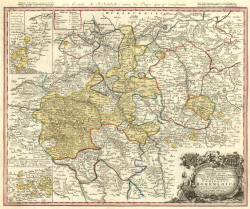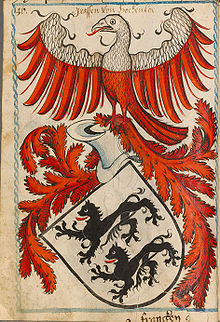Hohenlohe
County (Principality) of Hohenlohe Grafschaft (Fürstentum) Hohenlohe | |||||||||
|---|---|---|---|---|---|---|---|---|---|
| 1450–1806 | |||||||||
 Hohenlohe estates, Homann 1748 | |||||||||
| Status | State of the Holy Roman Empire | ||||||||
| Capital | Öhringen | ||||||||
| Religion | Roman Catholic Lutheran | ||||||||
| Government | Monarchy | ||||||||
| Margrave | |||||||||
• 1157–70 | Albert the Bear (first) | ||||||||
• 1797–1806 | Frederick William IV (last) | ||||||||
| History | |||||||||
• Established | 1450 | ||||||||
| 13 May | |||||||||
| 1500 | |||||||||
| 21 May 1744 | |||||||||
| 12 July 1806 | |||||||||
| |||||||||
Hohenlohe[needs German IPA] is the name of a German princely dynasty descended from the ancient Franconian Imperial immediate noble family that belonged to the German High Nobility (Hoher Adel). The family was granted the titles of Count (in 1450) and, later, Prince (see below). In 1806 the Princes of Hohenlohe lost their independence and their lands formed part of the Kingdoms of Bavaria and of Württemberg by the Act of the Confederation of the Rhine (12 July 1806).[1] At the time of this mediatization in 1806, the area of Hohenlohe was 1 760 km² and its estimated population was 108,000.[2] The Act of the Confederation of the Rhine deprived the Princes of Hohenlohe of their Imperial immediacy, but did not confiscate their possessions. Until the German Revolution of 1918–19 the Princes of Hohenlohe, as other mediatized families, had important political privileges. They were considered equal by birth (Ebenbürtigkeit) to the European Sovereign houses. In Bavaria, Prussia and Württemberg the Princes of Hohenlohe had hereditary right to sit in the House of Lords. In 1825 the Assembly / Diet of the German Confederation recognized the predicate of "Serene Highness" (Durchlaucht) for the heads of the Hohenlohe lines.[3]
History
An early ancestor was mentioned in 1153 as one Conrad, Lord of Weikersheim. His son Conrad jun. called himself the possessor of Hohlach (Hohenloch or Hohenlohe) Castle near Uffenheim, and the dynasty's influence was soon perceptible between the Franconian valleys of the Kocher, the Jagst and the Tauber Rivers, an area that was to be called the Hohenlohe Plateau.[4] (In 1378, Hohenlohe was sold to the Burggraves of Nuremberg [5]).
Heinrich I (died 1183) was the first to take the name of Hohenlohe, and in 1230 his grandsons, Gottfried and Conrad, supporters of Emperor Frederick II, founded the lines of Hohenlohe-Hohenlohe and Hohenlohe-Brauneck, names taken from their respective castles. The latter became extinct in 1390, its lands passing later to Brandenburg, while the former was divided into several branches, only two of which, however, Hohenlohe-Weikersheim and Hohenlohe-Uffenheim-Speckfeld, need be mentioned here. Hohenlohe-Weikersheim, descended from Count Kraft I (died 1313), also underwent several divisions, that which took place after the deaths of Counts Albert and George in 1551 being specially important. At this time the lines of Hohenlohe-Neuenstein and Hohenlohe-Waldenburg were founded by the sons of Count George. Meanwhile, in 1412, the family of Hohenlohe-Uffenheim-Speckfeld had become extinct, and its lands had passed through the marriages of its heiresses into other families. George Hohenlohe was archbishop of Esztergom (1418–1423), serving the King Sigismund of Hungary (later also Holy Roman Emperor and King of Bohemia).
In 1450, the Roman King Frederick III granted Kraft of Hohenlohe (died 1472) and his brother, Albrecht, the sons of Elizabeth of Hanau, heiress to Ziegenhain, the title of Count of Hohenlohe and Ziegenhain (Graf von Hohenlohe and zu Ziegenhain) and invested them with the County of Ziegenhain.[6] Actually, the Landgraves of Hesse took the County of Ziegenhain, and the House of Hohenlohe eventually gave up the reference to Ziegenhain.
The Hohenlohe possessions were located in the Franconian Circle, and the family had two voices in its Diet / Assembly (Kreistag).[7]
The Hohenlohe family had six voices in the Franconian College of Imperial Counts (Fränkisches Reichsgrafenkollegium) of the Imperial Diet (Reichstag).[8] The right to vote in the Imperial Diet / Assembly gave a German noble family the status of Imperial State (Reichsstand) and the right to belong to the High Nobility (Hoher Adel).
The existing branches of the Hohenlohe family are descended from the lines of Hohenlohe-Neuenstein and Hohenlohe-Waldenburg, established in 1551 by Ludwig Kasimir (d.1568) and Eberhard (d. 1570), the sons of Count Georg (d.1551).[9] The former of these became Protestant, while the latter remained Roman Catholic.
Of the family of Hohenlohe-Neuenstein, which underwent several partitions and inherited Gleichen in 1631, the senior line became extinct in 1805, while in 1701 the junior line divided itself into three branches, those of Langenburg, Ingelfingen and Kirchberg. Kirchberg died out in 1861, but members of the families of Hohenlohe-Langenburg and Hohenlohe-Ingelfingen are still alive, the latter being represented by the branches of Hohenlohe-Ingelfingen (became extinct in 1960) and Hohenlohe-Öhringen. The Roman Catholic family of Hohenlohe-Waldenburg was soon divided into three branches, but two of these had died out by 1729. The surviving branch, that of Schillingsfürst, was divided into the lines of Hohenlohe-Schillingsfürst and Hohenlohe-Bartenstein; other divisions followed, and the four existing lines of this branch of the family are those of Waldenburg, Schillingsfürst, Jagstberg, and Bartenstein. The family of Hohenlohe-Schillingsfürst possessed the duchy of Ratibor and still owns the principality of Corvey, inherited in 1834.
The Roman Emperors granted the title of Imperial Prince (Reichsfürst) to the Waldenburg line (in 1744) and to the Neuenstein (Öhringen) line (in 1764).[10]
In 1757, the Roman Emperor elevated possessions of the Waldenburg line to the status of Imperial Principality.[11]
In 1772, the Roman Emperor elevated possessions of the Neuenstein and Langenburg lines to the status of Imperial Principality.[11]
Family members

Notable members of the von Hohenlohe family include:
- Heinrich von Hohenlohe, 13th-century Grand Master of the Teutonic Knights
- Gottfried von Hohenlohe, 14th-century Grand Master of the Teutonic Knights
- Frederick Louis, Prince of Hohenlohe-Ingelfingen (1746–1818), Prussian general
- Louis Aloy de Hohenlohe-Waldenburg-Bartenstein (1765–1829), marshal and peer of France
- August, Prince of Hohenlohe-Öhringen (1784–1853), general
- Prince Alexander of Hohenlohe-Waldenburg-Schillingsfürst (1794–1849), priest
- Kraft, Prinz zu Hohenlohe-Ingelfingen (1827–1892), Prussian general and writer
- Victor I, Duke of Ratibor, Prince of Corvey, Prince of Hohenlohe-Schillingsfürst (1818–1893)
- Prince Chlodwig zu Hohenlohe-Schillingsfürst (1819–1901), Chancellor of Germany
- Gustav Adolf Hohenlohe (1823–1896), a Roman Catholic cardinal
- Prince Konrad of Hohenlohe-Waldenburg-Schillingsfürst (1863–1918), Austrian statesman and aristocrat
- Prince Friedrich Franz von Hohenlohe-Waldenburg-Schillingsfürst (1879–1958), Austrian military attache and later German spy-master. His first wife, Stephanie von Hohenlohe (1891–1972), was a German spy in the 1930s and at the start of WWII.
- Gottfried, Prince of Hohenlohe-Langenburg (1897–1960), husband of Princess Margarita of Greece and Denmark (1905–1981), the sister of Prince Philip, Duke of Edinburgh
-
Prince Chlodwig zu Hohenlohe-Schillingsfürst (1819–1901), Chancellor of the German Empire (1894–1900)
-
Prince Konrad of Hohenlohe-Waldenburg-Schillingsfürst (1863–1918), Prime Minister of Austria-Hungary (1906)
Castles of the House of Hohenlohe
-
Langenburg Castle*
-
Öhringen Castle
-
Neuenstein Castle*
-
Bartenstein Castle* near Schrozberg
-
Waldenburg town and castle*
-
Schillingsfürst Castle*
-
Haltenbergstetten Castle*
-
Kirchberg Castle
-
Rudy near Ratibor, Silesia (Poland)
-
Imperial Abbey of Corvey*, Westfalia
-
Grafenegg Castle*, Lower Austria
(*) still owned by members of the House of Hohenlohe
Heads of existing branches
Neuenstein line
- Hohenlohe-Langenburg branch: Philipp, 10th Prince of Hohenlohe-Langenburg (born 1970), at Langenburg castle
- Hohenlohe-Oehringen branch: Kraft, 9th Prince of Hohenlohe-Oehringen, 5th Duke of Ujest (born 1933), at Neuenstein castle
Waldenburg line
- Hohenlohe-Bartenstein branch: Ferdinand, 10th Prince of Hohenlohe-Bartenstein, (born 1942), at Bartenstein castle
- Hohenlohe-Jagstberg branch: Alexander, 2nd Prince of Hohenlohe-Jagstberg (born 1937), at Haltenbergstetten castle
- Hohenlohe-Waldenburg-Schillingsfürst branch: Felix, 10th Prince of Hohenlohe-Waldenburg-Schillingsfürst (born 1963), at Waldenburg castle
- Hohenlohe-Schillingsfürst branch: Constantin, 12th Prince of Hohenlohe-Schillingsfürst (born 1949), at Schillingsfürst castle
- Ratibor and Corvey branch: Viktor, 5th Duke of Ratibor and 5th Prince of Corvey, Prince of Hohenlohe-Schillingsfürst-Metternich-Sándor (b. 1964), owner of the Imperial Abbey of Corvey as well as Grafenegg and Neuaigen castles, Lower Austria
Legion de Hohenlohe
The Legion de Hohenlohe was a unit of foreign soldiers serving in the French Army until 1831, when its members (as well as those of the disbanded Swiss Guards) were folded into the newly-raised French Foreign Legion for service in Algeria.
Notes
- ^ Hölzle. Der deutsche Südwesten am Ende des alten Reiches (Stuttgart : 1938) : page 102.
- ^ "Map of Baden-Wurttemberg 1789 - Northern Part". hoeckmann.de.
- ^ Almanach de Gotha : 1910; pages 140-148.
- ^ Europäische Stammtafeln: Neue Folge; Band XVII (1998); table # 1
- ^ Stokvis. Manuel d'histoire, de généalogie et de chronologie (Leiden : 1887–1893): tome III; pages.354-356.
- ^ Europäische Stammtafeln: Neue Folge; Band XVII (1998); table # 3; Almanach de Gotha, 1941; page 216.
- ^ Berghaus. Deutschland seit hundert Jahren (Leipzig : 1859–1862): Abtheilung I; Band I; page 165.
- ^ Lancizolle. Uebersicht der deutschen Reichsstandschafts- und Territorial-Verhältnisse(Berlin : 1830) : page 8, 46
- ^ Europäische Stammtafeln: Neue Folge; Band XVII (1998); tables # 4,6,15
- ^ Frank. Standeserhebungen und Gnadenakte für das Deutsche Reich und die österreichischen Erblande (Senftenegg : 1967–1974): Band 2; page 221
- ^ a b Frank. Standeserhebungen und Gnadenakte für das Deutsche Reich und die österreichischen Erblande (Senftenegg : 1967–1974): Band 2; page 221.
References
- Genealogy of the House of Hohenlohe
- This article incorporates text from a publication now in the public domain: Chisholm, Hugh, ed. (1911). "Hohenlohe". Encyclopædia Britannica. Vol. 13 (11th ed.). Cambridge University Press. pp. 572–575.
- See generally A. F. Fischer, Geschichte des Hauses Hohenlohe (1866–1871),
- K. Weller, Hohenlohisches Urkundenbuch. 1153–1350 (Stuttgart, 1899–1901), and
- Geschichte des Hauses Hohenlohe (Stuttgart, 1904). (W. A. P.; C. F. A.)
- European Heraldry page
- The House of Hohenlohe
















